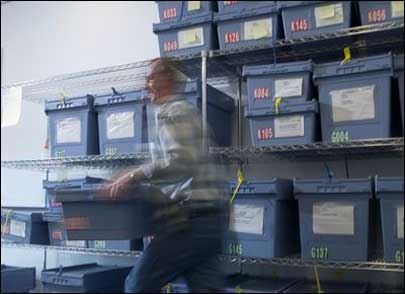The Dutch Forensic Institute (NFI), a government agency that collects and evaluates crime-scene evidence from around the Netherlands, has implemented an RFID track-and-trace system for the 100,000 pieces of evidence it collects every year. Guns, knives, cigarette butts, hair samples and other items are placed in plastic bags at crime scenes, and labeled with EPC Gen 2 RFID tags.
The system enables officials to document each item’s chain of custody in the event of an accusation that evidence has been tampered with, or is unrelated to a particular case. The system also warns NFI’s managers if any items are moved without permission.
Implemented by Atos Origin in Arnhem, the project may be the first item-level RFID project in the Netherlands for objects that are of a wide variety of shapes and sizes, says Johan Klunder, company’s RFID project manager. A similar but much smaller system currently operates in Texas (see Travis County Fire Marshall Uses RFID to Manage Evidence).
Atos Origin began designing and implementing the system at the start of 2007, and it was officially inaugurated earlier this month by the Dutch Ministry of Justice, which oversees the NFI. When the institute offered the tender to the market, it had already conducted substantial research on the technologies available, and specifically wanted an RFID system to replace its tracking system, which was based on bar-coded labels and handwritten notes.
The NFI sought an application that would reduce the work and decrease the errors created by tracking, by hand, every movement of evidence shared by investigators and prosecutors. The NFI also faced the problem that 26 police districts around the country used different numbering systems. As a result, several pieces of evidence collected at the NFI in the Hague can carry the same number but originate from different districts.
At a crime scene, police officers place adhesive labels on individual plastic bags holding evidence. The labels include an embedded RFID tag, readable text and a bar-coded serial number. A smaller adhesive label, with the same bar-coded number, is then attached to a sheet utilized for logging the evidence.
The bags are placed in a plastic crate that is then transported to a service entrance at the NFI. At this point, an RFID interrogator installed at the door makes the first of dozens of potential tag reads. Workers go through a receiving process of opening the crates and collecting the documents and evidence contained within, then employ a handheld reader to interrogate the tags a second time.
Project partners are presently working to develop an automatic reading station for this read point, Klunder says, which resembles an airport luggage scanner. The evidence will move on a belt into a tunnel-shaped portal that reads the bags’ RFID tags and photographs the evidence. The custom portal will be ready by the end of the year, he adds.
The NFI’s headquarters has four floors and houses seven separate departments, such as those specializing in DNA, fingerprints, ballistics or digital evidence. Klunder and his team divided the building into 25 zones, each with two entrances. The team installed an RFID interrogator into each of the 50 doorways separating the zones. Once evidence has been checked in, employees must move it on a trolley or carry it to the correct department. As they do so, the tags are read as the evidence is moved from one zone to another. By calculating differences in read times, the system can determine if an item was moved into or out of a zone.
Workers must scan their badges to enter secure areas. This information is collected so system managers can determine which workers moved which evidence, and at what time. An audible and visible alert informs the staff that all tags have been read. In addition, if a person attempts to move the tagged evidence outside of the building or into an unauthorized area, an alarm will sound.
Evidence may remain at the NFI for months, moving from one department to another multiple times. And officials estimate that at any given time, the agency maintains an average of 400,000 pieces of evidence within the facility. Klunder says he expects 800,000 reads to be made and stored during a single year.
Atos Origin built its track-and-trace solution on software from U.S. software maker GlobeRanger. The interrogators are connected to a GlobeRanger iMotion Edgeware server, which filters and interprets the reader data, and also controls the alarms. Feig Electronic supplied the RFID interrogators used in the application, while Alien Technology provided the RFID tags. NFI utilizes EPC Gen 2 tags but does not encode them with an EPC number. Instead, it relies on its own numbering system.
The Dutch Forensic Institute has not yet calculated an estimated return on its investment, since the system’s purpose is to improve the integrity of the evidence-management process.



